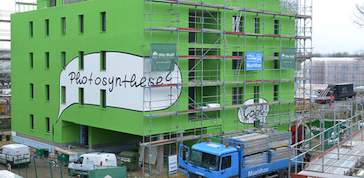The 15-apartment block has 129 algae filled tanks hanging over the exterior of the south-east and south-west sides of the building— powered exclusively by algae.
The fast-growing algae not only create biofuel, they also produce heat, shade the building, and abate street noise. The algae were retrieved from the nearby Elbe river, and put into large thin rectangular clear cases. Inside, the algae live in a water solution and are provided nutrients and carbon dioxide by an automated system. Each tank was then affixed to the outside walls of the building onto scaffolding that allows for turning the tanks towards the sun—similar to technology used for solar collectors.
In ten years, everyone will be doing it.
As the algae grows—mostly in the summer—it provides more shade for the building, helping to keep it cool (and serves as a sound buffer as well). Excess heat that builds up in the water in the tanks is transferred to saline water tanks underneath the building for use later. When the amount of algae growth in the tanks reach a certain point, some is harvested and taken to a processing facility inside the building. There the biomass is converted to biogas which can be burned to provide heat in the winter. Thus, the building makes use of both solar thermal and geothermal energy allowing it to be heated and cooled without using any fossil fuels.
Jan Wurm, one of the chief designers of the energy system and associate director of Arup, the multinational engineering firm in the winning consortium, describes bioreactors on his Web site, Smartgeometry, as ‘‘transparent containers which create a controlled environment for photosynthesis.’’
The algae are fed liquid nutrients and carbon dioxide to encourage growth. Pressurized air is pumped into the panels to increase growth and prevent the micro-organisms from settling down and causing rot, Mr. Wurm said. He noted that scrubbers in the panels automatically kept the glass clean. The panels double as solar thermal collectors to convert sunlight into usable energy.
‘‘The part of the light which is not absorbed by the algae for the photosynthesis is converted into heat,’’ Mr. Wurm said, and can be used immediately for hot water or stored in the building’s underground geothermal system.
The design and construction of the building has taken a team including Arup, SSC Strategic Science Consultants and Splitterwerk Architects three years and has cost approximately €5 million, all funded by Internationale Bauausstellung (IBA) as part of the ongoing International Building Exhibition – 2013. To highlight the building, the team has painted its exterior green and has added a giant cartoon-like bubble on one side with the word “Photosynthesis?” in it.
\
The building is to serve as a test case and will be studied by various architects and engineers from around the world to determine if the design is feasible and if so, to perhaps serve as a model when erecting buildings in other cities.
powkey Portable Power Station 350W, 260Wh/70,000mAh Backup Lithium Battery, 110V Pure Sine Wave Power Bank with 2 AC Outlets, Portable Generator for Outdoors Camping Travel Hunting Emergency
Now retrieving the rating.
$192.98 (as of April 18, 2024 14:24 GMT +01:00 - More infoProduct prices and availability are accurate as of the date/time indicated and are subject to change. Any price and availability information displayed on [relevant Amazon Site(s), as applicable] at the time of purchase will apply to the purchase of this product.)200W Portable Power Station, Powkey 120Wh/33,000mAh Power Bank with AC Outlet, 110V 6 Outputs Solar Generator External Battery Pack with LED Light for Home Use and Outdoor Camping
Now retrieving the rating.
31% OffPortable Power Station 600W, Powkey 296Wh Battery Backup with 2 Pure Sine Wave AC Outlets, USB-C PD100W and 2 Wireless Chargers, Solar Generator (Solar Panel Optional) for Outdoor Camping/RVs/Home Use
Now retrieving the rating.
10% OffFoldable Solar Panel Charger 60W with 18V DC Output (11 Connectors) for 100W~350W Portable Power Stations Jackery/Rockpals/Flashfish/Enginstar, Portable Solar Generator for Outdoor Camping Van RV Trip
Now retrieving the rating.
$98.99 (as of April 18, 2024 14:24 GMT +01:00 - More infoProduct prices and availability are accurate as of the date/time indicated and are subject to change. Any price and availability information displayed on [relevant Amazon Site(s), as applicable] at the time of purchase will apply to the purchase of this product.)10W USB LED Light for Camping Garage Warehouse Car Truck Fishing Boat Outdoor Portable Bulb, Emergency Light, Children Bed Lamp
Now retrieving the rating.
$9.99 (as of April 18, 2024 14:24 GMT +01:00 - More infoProduct prices and availability are accurate as of the date/time indicated and are subject to change. Any price and availability information displayed on [relevant Amazon Site(s), as applicable] at the time of purchase will apply to the purchase of this product.)






